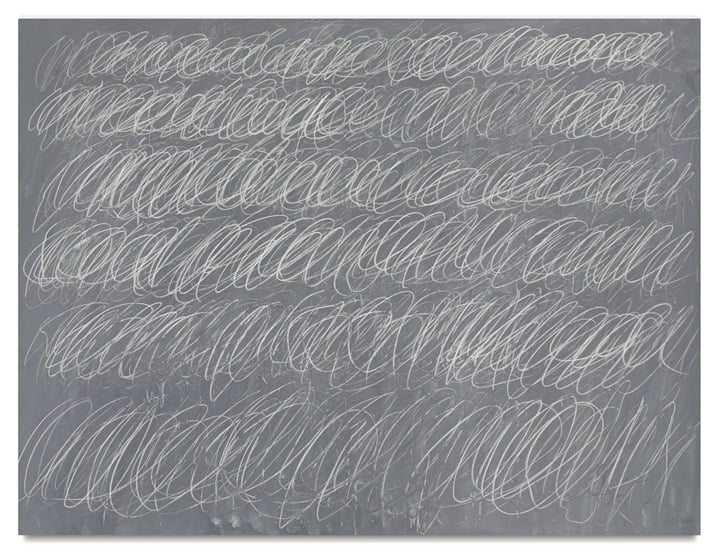
Untitled (New York City), a 1968 Cy Twombly “blackboard” painting, set a new auction record for the artist at $70.5 million at Thursday night’s postwar and contemporary art sale at Sotheby’s New York. It was the top lot in a solid $295 million sale (and also happened to be the priciest item Sotheby’s has sold this year).
It edged past the artist’s previous auction record by not even $1 million, but it’s worth noting that that previous record was set just one year ago, at Christie’s New York, for another painting in the same style.
“I was expecting an even higher price,” dealer Karsten Greve, told artnet News in a phone conversation. “I’m not surprised at all about the price, not at all,” he admitted, noting he thought it could have sold for as much as $75 million.
Half of Twombly’s top ten prices at auction, all north of $15 million, are for chalkboard paintings that have been sold since 2011, the year the artist died in Rome at age 83.
One of those was at Sotheby’s London this past February. The painting in question fetched $30 million, nearly doubling in value over three years: Hollywood film producer Stavros Merjos, the seller that night, had bought it at Sotheby’s New York in 2012 for $17.4 million, a record at the time.
Cy Twombly, Ferragosto (1961).
Photo: Thomas Ammann Fine Art, Zurich.
The “blackboard” works are part of a larger group of gray paintings created between 1966 and 1973. “Gray is one of the most delicate and difficult colors,” said Greve, noting that it’s very attractive to major artists. “Most people they would love a colorful Van Gogh painting but you should see the gray paintings by Van Gogh; They’re fantastic.”
Greve recognizes the “blackboard” paintings as part of Twombly’s genius production, and “one of his great moments,” but is quick to clarify that he doesn’t think it is the best of his work.
“Twombly’s one of the greatest artists of the last 100 years,” said Greve who has galleries in Cologne, Paris, and St. Moritz, and first exhibited the the Kentucky-born artist’s work in 1971. Twombly, he said, has become “very influential for generations of younger artists.”
A giant of 20th-century art history, Twombly appeared in the Venice Biennale in 1964, 1989, and 2001, receiving a Golden Lion in 2001. The Whitney Museum of American Art and the Museum of Modern Art (both in New York) and London’s Tate Modern have organized surveys of his work.
Greve sees a growing demand for Twombly works across all stages of his career. “The body of his work is very small,” explained Greve. “I would say Twombly did something like 650 paintings.”
By comparison, he points to Andy Warhol, who created over 10,000 works. “That’s a different story, you know?”
“If all the major museums in the world, if they want an important Twombly painting, there will be very soon nothing on the market anymore,” he predicted. “It will be very hard to find any good material. I’m expecting the Twombly market you will see colossal prices.”
“I would say if you would have a Ferragosto painting coming up it might go up between $60 million and $90 million as there are only four of them,” he said about the luridly colored canvases with fecal-like smears. Could the elite $100 million club soon have another member?
“The whole thing started with the line,” said Greve about the “blackboard” works, noting the powerful energy and motion captured in the scribbled waves. “[Twombly] was creating his own language and he was using this type of painted surface which was astonishing and not seen before…. On the other side it’s a common language that everyone can read.”